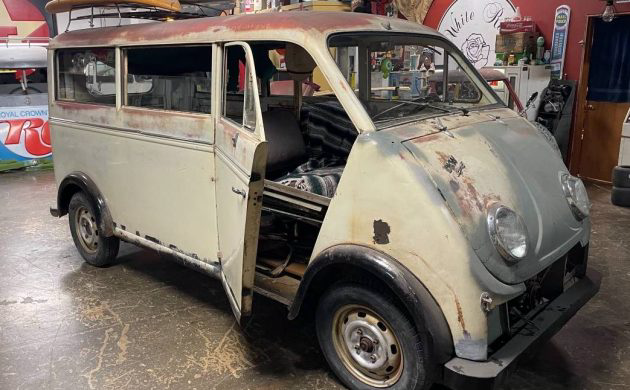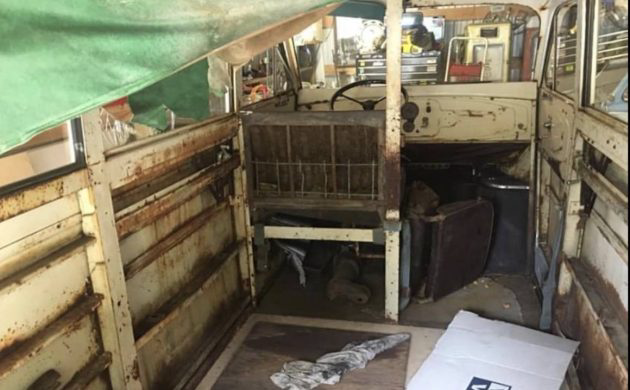Before there was the minivan, and Audi for that matter, there was the Schnellaster F89 L from DKW which was part of Germany’s Auto Union. This FWD gem was offered between 1949 and 1962 and focused on getting the most from the least in terms of size anyway. Overshadowed by the VW Type II, the Schnellaster was certainly a worthy competitor and an interesting vehicle in its own right. This example is located in Monroe, Washington and is available, here on craigslist for $9,850.
The Schnellaster was produced as a panel van, a people van, and supposedly, a pickup truck too. Our example is windowed like a people mover but the interior is gutted for commercial type use. One of this van’s selling features was its low, close-to-the-ground loading deck, and its single, hearse-like hinged rear door. In profile, it reminds me of the Scion xB.
The immediate feature that caught my attention is this van’s “Beetlesque” headlight appearance, it has an almost cheerful, child-like bearing. The seller states, “Original paint with very cool sun-cooked patina…” that appears to be true and it is genuine and not forced. There is surface rust that is visible but there is no indication of serious rot though there is something going on along the lower edge of the rear door and in the rocker panel area. The haphazardly applied gray primer is distracting in terms of trying to assess the body’s true condition. The seller does claim that the underside and frame are solid. Unfortunately, the cool-looking Bonneville Salt Flats wheels and the roof rack/surfboards are not included in the sale.
Motivational power comes from an unusual source in the form of a 32 HP, 900 CC, in-line, three-cylinder, two-stroke engine. The seller advises that it doesn’t run which is no surprise considering that it is apart. He adds that he has a spare engine included in the sale. Gear changes occur via a column-shifted, four-speed manual transaxle.
There’s not a lot that can be said about the interior, it is stripped out for hauling and there is what appears to be a plywood floor in place. The instrument panel is minimalist but the Auto Union marked speedometer is in excellent condition, reads in MPH, and shows 34K miles on its odometer – actual mileage? No way to know for certain. It’s a blank canvas but considering all of its glass area, building it out as a transporter would seem logical. Of course with only 32 HP, there’s a limit to how much hauling or transporting this van can handle.
It’s a neat, unusual vehicle no doubt, but the price seems steep considering the engine’s current state of affairs. One can ponder what to do with this van as in restore it, modify it, or use it as a static display. Absent mechanical upgrades, and assuming this Schnellaster was a running example, one has to ask how extensive the market is for an obscure two-stroke, 32 HP van?








Looks like an absolute summer sweatbox.
They’re great wee town vans. Optimum use of space, and ultimate speed doesn’t really matter if you’re just popping around doing deliveries.
‘Original paint with very cool sun-cooked patina…’ At what point did a rusty paint job become a good thing?
The inside of this Schnitzellaster (I hope I’m spelling it correctly…LOL) looks like a horse stable.
Stables routinely look a whole lot better than this does.
Ein gross Witz,schrott! ( A big joke,scrap.
DKW.Das Kleine Wunder–The Little Wonder.
I’ve paid attention to cars for my entire life and never heard of this one. Something tells me you won’t be ordering parts from Rock Auto….
Why not? They do list parts for DKW cars. Not many but some.
Yeah, coil, spark plugs, and wiper blades…
A blank slate. Put modern mechanicals in it and restore the rest. Guaranteed to hear “what the hell is that?!” at every stoplight, grocery store parking lot and car show.
I can just imagine what my old man would have thought. “Hey dad, look at my Schnellaster van”. Probably get his shotgun and fill it full of holes( flashing back to war years) Again, neat little thing, horribly underpowered for any American duty, but the sky is the limit here. Just no 3 cylinder ring-dings, if even allowed anymore.
Amazing and very sha-weet lookin.’ Make it electric and start pumping them out by the thousands!
You had me at “column-shifted four speed manual”.
Restored values on these are eye popping. Here is a pickup version that hammered for $120,000 six years ago.
https://www.hemmings.com/stories/2015/01/09/rare-1955-dkw-schnellaster-tieflader-36-pickup-heads-to-auction
a coil for each cylinder?
There was no distributor per se. Instead there was a breaker plate at the front of the crankshaft with three sets of points and three condensers. Each cylinder had its own coil.
What could possibly go wrong???
It’s a two-stroke.
Will it have 4 rims and tires installed prior to shipping?
Doesn’t appear to be any glass in it accept the rear window and vent wings. Maybe I see a windshield there. All looks flat, though, should be an easy fix.
These vans existed in Rhodesia in the late 50’s early sixties. Usually in a pale blue colour. Never saw one speeding down the highways which we didn’t have anyway! They bore the Auto Union badge.
Nein,Ersatzteil sind nicht lieferbar.Alt Deutsche schrott oder witz.
Yeah,,,think about it,,
My older brother had one of these in the yellow color California in the late 1970s. It had a metal sunroof that slid all the way back and opened up half of the roof. We put daisy decals on the Windows after tinting them dark black it was the perfect Hippie Mobile. One of the great things about the Flathead 3 cylinder 2 cycle was could crank it over manually backwards. It would run either way but when you started the engine in the reverse orientation you had 4 gears reverse and one gear forward, many an afternoon having fun with that feature LOL. My brother was a mechanic by trade and drove the dkw van for years, it had a comical funny face and everybody loved it and many people tried to buy it.
Guys in 2014 a fully restored panel Schnellaster sold for $60,500 at a US Auction. Someone I know bought one that had been convert to run on a VW Beetle engine and the price tag was $20K and it was a poor driver. I don’t think this is over priced. Check the cars in the background, I bet the shop knows what’s up.
Am I the only one that sees the cargo floor deck is untreated plywood sheet?
And yes it did indeed have a separate coil for every cylinder and I believe a separate condenser also. It was a true Willy Wonka machine. Unlike anything I have ever seen or driven since. In Germany that called them a DOR Cher. Kinder. Wagon. Which was German for little baby wagon. They did indeed have the four Circle Auto Union badge on the hood which exactly matches the current Audi emblem
The joke being that dkw stood for little baby wagon. Anyway the stories I could tell you about the times we had in that van would take up far more pages than we have here
My recollection is that prior to WWII Auto union and Volkswagen came from the same group hence the same lights and generic two stroke engine. After WWII bringing new vehicles to the market was a priority and so widespread use of the same parts bins for DKW/ later Auto Union, and of course early porsche. Concurrently in the Eastern zone the Auto Union auto plant in Eisenach was taken over by the Communist Government and copies of the pre/post war Auto Union were manufactured under the IFA name. I had the pleasure of driving both an IFA and its later incarnation the Wartburgh.Three cylinder two strokes were fast and relatively
Trouble free but generated copious fumes!
Hmm. Somebody took the parts bin idea to the extreme here.
Years ago a friend had a 3 cylinder SAAB sedan that had a weird sound and his 3 very young daughters called it the Putty-Put car.This was a 2 cycle engine.There was a lot of peculiar little cars came out of Europe after WW2 and one of my German friends had a Trabant that was (I think) made of fiber glass and had a fuel shutoff under the dash on the passengers side and a warning said the fuel could be shut off accidently if a person with a long foot
hit that valve.An engineering master piece or “Ein meisterstuck aus Ost Deutscheland.
DKW developed the modern loop scavenged 2-stroke engine. They were popular in Sweden before WW2 because they would crank over no matter how cold it was (no oil in the crankcase). So Saab started to build their own version after the war. Driven by the great Eric Carlson they won so many rallies the organizers started to make up rules to penalize them. I own a ’66 Saab 2-stroke. Top speed 95mph, disk brakes, and it’s a lot smoother than a VW bug.
The Schnellaster was a brilliant design for it’s time and place. I don’t know why no one every copied it’s cargo space construction. The rear wheels are separately suspended on trailing arms, so there’s not axle across the back. The floor of van is only about a foot off the ground and it’s completely flat and unobstructed.